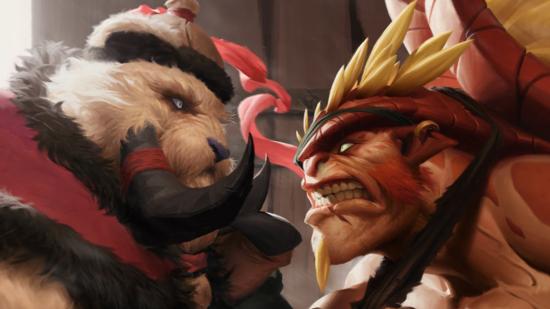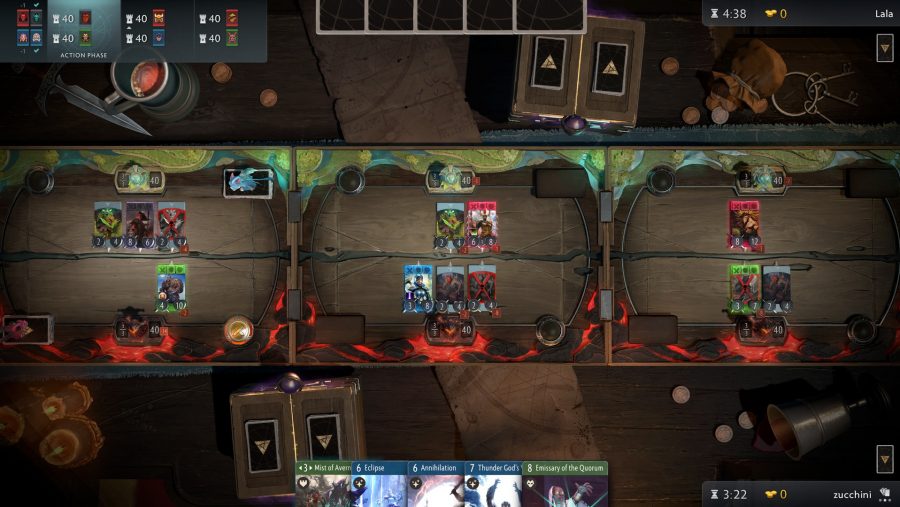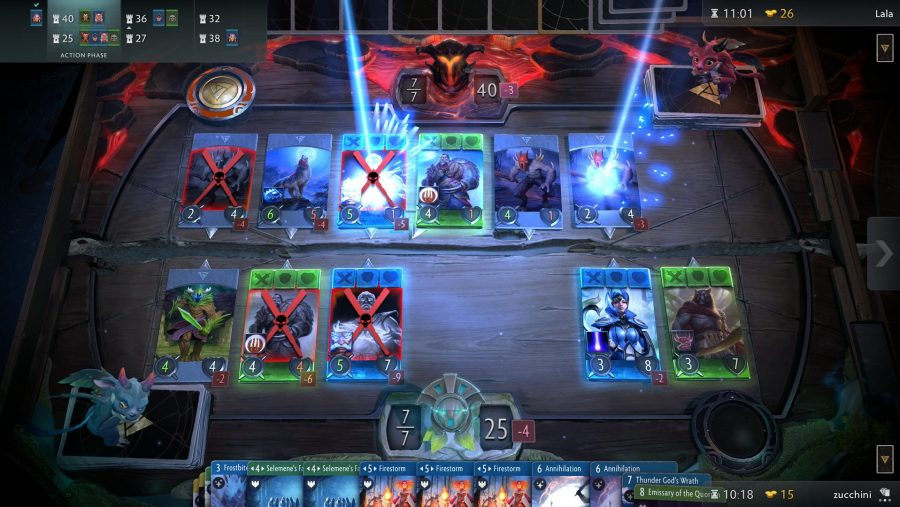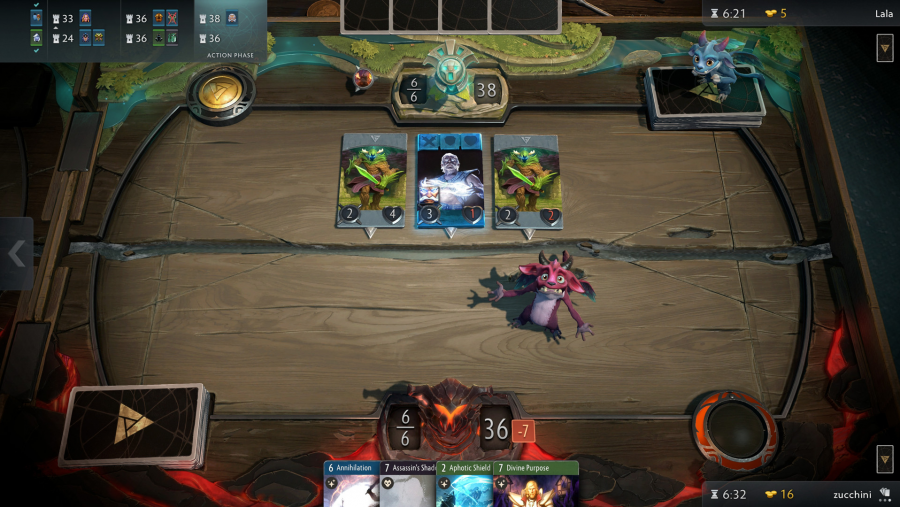Valve’s next game is Artifact. It’s a Dota-branded take on digital trading card games that has gathered its fair share of detractors since its unveiling. There’s no escaping that fate for any Valve game that doesn’t have a ‘3’ in the title. But those early reactions had nothing to do with the game itself, and on its public debut at PAX West this weekend, Artifact has shown itself to be a card game of notable depth and complexity.
We got the chance to talk with two of the people responsible for bringing the game to life: programmer Jeep Barnett, who’s been with Valve for over a decade, and game designer Richard Garfield, who came to the company with an idea for a digital card game that could capture the scope of his own Magic: The Gathering in a new format.
Together, they addressed the reaction to the game, how it will integrate into the Steam Marketplace, and how the team plans to build future expansions. The pair also told us the story of how Artifact came to be, and why it’s a Dota product instead of taking on another name from Valve’s library of games, like Counter-Strike or Team Fortress 2.
PCGamesN: The reaction to Artifact has shifted dramatically over the past year. What do you think is responsible for that?
Jeep Barnett: I watch people play the game all the time. I try to figure out how we can help people understand the game, teach them the game. When people come in, they’re like ‘why are you making this game?’. Then they sit down and play it, and they’re like ‘can I please be in the beta?’. The thing we’ve found is that people – once they’ve played the game, or once they’ve seen it in action – really see the potential that’s there.
When we initially announced Artifact, we hadn’t shown any gameplay footage, and we hadn’t talked about Richard’s involvement – which I think is a second big piece of that. He brings a pedigree to the game that proves it’s very well thought out. I think it’s just people becoming more familiar with our intentions and what type of game it is, and where we’re going in these coming years, that has made people more and more excited about it.

Artifact offers Steam Marketplace interaction, letting you buy and sell cards on the store. How does that work?
JB: Any card that you buy, or that you get when you buy the game, you can sell on the market. You can set whatever price you want – it’s an open market. Any cards that you want to put in your deck you can buy individual cards from other players on the market, or you can buy packs for those.
We think it’s really important that – and Magic has a history of this – the cards that you’re playing with retain value. And that, in the coming years, they’ll still have that value. Even as additional sets come out, the competitive scene might be playing with this specific set of cards.
But we really wanted to focus on players being able to play with their group of friends and with their communities. And for those communities to build other mode types, where they play classic mode where it’s only the first set, or we want to play with just the common cards, or they build cubes that you draft from. These specific sets of cards that have these specific features are what we’re interested in. I think that helps cards maintain value for a long time, if you can use them in all these different modes of play.
Do you have the path for future expansions already in mind?
JB: We’re not going to say exactly what we’re doing in the next expansions, but we’ve already started thinking about designing them, and Richard’s a key part of that.
Richard Garfield: In the beginning, we’re staking out strategic territories, seeing what mechanics would shift the game strategies, and disrupt whatever the top strategic foundations are. Because if you can upset those, you can create new, interesting play space. Mechanically, we work our expansions around those. Flavour-wise, we usually pick some theme to build around, which in this case will tie into the Dota world. Some subset of heroes which we think will translate well to the card game.
JB: We want to think of the story in this game as something that progresses with each expansion. Events that take place thematically in this set, the results of those battles, and those heroes and their relationships, will change within the next set.
RG: With the expansion pacing, it’s a balancing act, because people want to see new things. But on the other hand, you can play the original cards essentially indefinitely. That sounds kind of surprising for a trading card game, most people think you need new blood going in, but you don’t.
The people at Valve have been playing the same set of cards since the beginning and they still want to play them. If new cards come out, that’ll be exciting, but there’s a lot of play value there. So you want to release cards in such a way that you don’t confuse the fact that you’ve really got this evergreen game, but at the same time provide ongoing interesting strategic shifts.
Valve’s development process seems to let ideas aggregate over time into games. At what point was it clear you were making a card game, and wanted the creator of Magic involved?
JB: With any game at Valve, this in particular, there’s a couple people at the company who are saying ‘I want to work on this type of game, this is the type of thing that I’m interested in’. Richard approached us with his concept of what he wanted to do, and we’re like ‘we really want to work with Richard, we’re going to learn a bunch from him, we think this is really exciting’, and the ideas he had were just kind of blowing our minds.
With everything we want to work on, it’s risky. Where’s it going to go? Is it actually going to be fun when we build it? How much work is going to be? So we start projects very small. It was Richard’s staff right at the start, just those four guys. They were playing the game on paper. They were writing down what the cards would do, playing them out on the table, and rolling dice. Making everything work and kind of tweaking the rules. Once they had something that felt like ‘ok, this is actually a really interesting game’, they started prototyping an electronic version of it – a very simple version.
Other people in the company would play that version of it. I was one of those people. They play just to test and work on balance and figure out new ideas. When I played I was like ‘wow, I really want to work on this. This game is really exciting’. I’m really into tabletop games and this type of game really excited me.
That’s usually how it goes. People at Valve will play a game that’s in development, and either they say ‘this is a game that I really want to see released’, or ‘this is a game that I feel I can really contribute to. If I join the team, these are the five things that I want to add to it, that I think would be really important, or really bring it over the top, or make it get even bigger than it was going to be before’.
The more and more people that do that, it’s like you said – it aggregates, or it sort of gloms on. It’s just a snowball that rolls down the hill that just keeps growing. At a certain point, you get to the bottom of the hill, I guess.
There are a lot of trading card games happening at the moment – including a proper online Magic. Does it feel like you’re competing with yourself at all?
RG: Well, it certainly didn’t begin that way, because one of the earliest inspirations for Artifact was that Magic has limitations to what you can do online. A true translation of Magic is really awkward online, and if you don’t do the true one, you’re not really reflecting what the tabletop experience is. So there were a lot of changes to that.
When we began this, the games that were out were much more narrow in scope than I was interested in. I wanted something that felt epic and unbounded, like Magic occasionally does when you play it. An example I’ve been giving – which literally happened – is that I was playing an electronic game and then went and played a game of Magic, and I had 30 token creatures out. And I was asking myself why you could have this crazy, fringe experience happen in a tabletop game, but it wasn’t happening in any of the electronic games because they were all so constrained. It should be easier in an electronic game.
So I was aiming for something closer to a real-time strategy game or a MOBA, where it was really big. Yet it had the pacing of a fast card game, where it didn’t feel you had to keep a whole bunch of balls in the air juggling. I feel like it’s carved out its own niche.
Did Dota come into the picture with this goal of spreading out the scope?
RG: The spreading out of the scope was part of the original document. When I began talking to Valve and we decided we were all interested in a partnership, we began to look at what properties made sense to build this around. That included the possibility of doing an original property, or Counter-Strike, or TF2 – I love that game, but it wasn’t as good a choice.
Dota really stood out as being the choice. It’s got a broad palate of things you can draw from. It’s got a wide range of game effects which you could translate to the card game. And they have the capability of adding what they need to it – you weren’t constrained, whereas you would be in a game like Counter-Strike where you’re constrained by real life. They could add things to the Dota world that makes the card game better.
Are you expecting to see the same sorts of dominant strategies that focus the meta of, say, Hearthstone, take shape in Artifact?
RG: I think at the top level of competitive play that is inevitable. What we would look for is having a top-level competitive area where there’s multiple competing strategies, and so you get this rich, diverse tournament structure. But we’re not narrowly focused on the top-level play. We want competitive play to be like a tent pole, with the tent encompassing a lot of other play.
So you get the kitchen table Magic play analogue, where people can play with their own sets of rules and their own level of seriousness. And the analogue of cube drafts, or Commander Magic, or something like that, where a lot of play in Magic is driven by the players, because they’ve got the cards. We want to give people the capability of doing that with Artifact as well.
Artifact is a very complex game compared to something like Hearthstone. What’s your plan to bring new players in?
JB: I watch a lot of new players play the game. Some of which have played Dota, and some have not, and some have played card games, and some have not. What I tend to see is an onion-layer phenomenon, where when people first approach the game, they see the surface level: ‘ok, these guys hit each other and then hit the tower, and I have some cards that do some things’.
But then you move past that layer, and you get to ‘well, I can redirect and hit that hero and kill him, but maybe I should be hitting the tower instead’. Or ‘I’m already hitting the guy, but maybe I should redirect and hit the tower instead’. And there’s this other layer where you have damage spells and you’re like ‘ok, I can kill their guys’, but then you see one of your heroes is at four health, and you’re like ‘wait a minute, if I kill that guy right now, I can move him to a different lane – I need to do that’.

So you start playing at this next level, where you’re using cards in ways that don’t seem intuitive. Then you get to another level, where there’s all this play with who has the initiative, who goes first in the lane. So you might have a really good play in lane two, but you don’t take it because you need to take the first play of lane three. Looking ahead and seeing those things, manipulating the initiative so that you’re going at the right times, trying to coordinate killing several heroes at once on the opponent’s team so that they’re all in the Fountain at the same time and you have free reign of the board. Rather than ‘oh, I’ll kill this guy this turn and this guy this turn and this guy this turn’.
There’s all these deeper levels that you get to the more you play, but – I’ve watched children play this game a few times, and it’s really interesting where they don’t really get the math of it. They don’t read what’s on the cards. They’re just like ‘this is a glowing card and I can put it on that glowing thing, and I’m just doing stuff’. It’s like a pachinko machine, where everything’s kind of bouncing off of each other and things are happening, and they’re happy, too. It’s really interesting that it appeals to people on so many different levels.
RG: I think people who first look at the game might think of a game like Hearthstone, and think it’s far more complex than they’re used to. But look at a game like StarCraft – that’s got broad appeal, from very serious players to very casual players, and it is very complicated. People can handle that. It’s a matter of whether this is a fun game space to explore, and whether you’ve done a good job of explaining the game state to players. Which I think Valve has done. So I think when they begin experiencing it, it’s going to be in a different place than they’re used to.

Artifact had been in testing among pro-level players for some time before being unveiled. Are there any specific examples of how their feedback has shaped the game?
JB: They’ve been playing since late last year. We have about 200 people in our private beta now, and they’re providing a lot of really interesting feedback because they come from a lot of other game scenes, sometimes competitive game scenes. I’m trying to think if I can nail down a specific example, but it’s almost countless, the number of things that we’ve seen that they’ve suggested and we’re like ‘wow, that’s a really good idea’. Or they find a unique combination of cards that we didn’t expect, and we’re like ‘oh, that’s actually a really weird way you can play with these cards’ that we hadn’t even thought of before. So we’ve been tweaking the balance of some of the cards in terms of their mana costs and different things like that.
But a lot of the changes we’ve done over the last year have been about presentation. Making sure that even though the game has all of this depth, you can access the different parts of that depth as needed. When you have to know ‘how much siege does that guy have, because if I play a creep in front of him he’s going to hit my tower’, you can go and find that information as needed. Basically, any card in the game, you can double-click on it and it’ll give you a breakdown of absolutely every stat related to that card, and even those things have sub-information that you can look at.
When you look at the attack on a card, and it’s a buffed attack, you can figure out where all those buffs are coming from. So you can say ‘oh, well, if he kills this creep over here I’m going to lose two damage, and that’s just enough to do away’. You can really map them out. They’ve provided a lot of feedback on making sure that those things are quickly accessible, and that as many of those things as possible are surfaced up so that you can see them.
People seeing Artifact at PAX are getting into the beta. Any word on how else people can expect to get in?
JB: We’re going to talk about that in the future. I don’t have anything to announce, but there will be opportunities.



